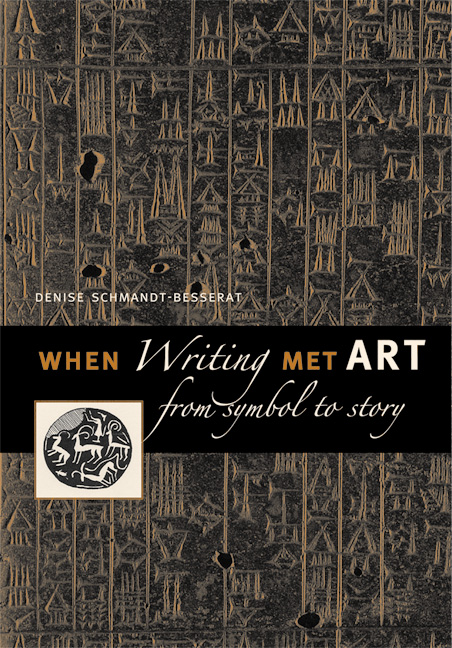Denise Schmandt-Besserat: When Writing Met Art: From Symbol to Story (2007)
Filed under book | Tags: · antiquity, archaeology, art, art history, history, mesopotamia, middle east, painting, writing

“Denise Schmandt-Besserat opened a major new chapter in the history of literacy when she demonstrated that the cuneiform script invented in the ancient Near East in the late fourth millennium BC—the world’s oldest known system of writing—derived from an archaic counting device. Her discovery, which she published in Before Writing: From Counting to Cuneiform and How Writing Came About, was widely reported in professional journals and the popular press. In 1999, American Scientist chose How Writing Came About as one of the “100 or so Books that shaped a Century of Science.”
In When Writing Met Art, Schmandt-Besserat expands her history of writing into the visual realm of communication. Using examples of ancient Near Eastern writing and masterpieces of art, she shows that between 3500 and 3000 BC the conventions of writing—everything from its linear organization to its semantic use of the form, size, order, and placement of signs—spread to the making of art, resulting in artworks that presented complex visual narratives in place of the repetitive motifs found on preliterate art objects. Schmandt-Besserat then demonstrates art’s reciprocal impact on the development of writing. She shows how, beginning in 2700-2600 BC, the inclusion of inscriptions on funerary and votive art objects emancipated writing from its original accounting function. To fulfill its new role, writing evolved to replicate speech; this in turn made it possible to compile, organize, and synthesize unlimited amounts of information; and to preserve and disseminate information across time and space.
Schmandt-Besserat’s pioneering investigation of the interface between writing and art documents a key turning point in human history, when two of our most fundamental information media reciprocally multiplied their capacities to communicate. When writing met art, literate civilization was born.”
Publisher University of Texas Press, 2007
ISBN 0292713347, 9780292713345
134 pages
Marcel Mauss: The Gift: Forms and Functions of Exchange in Archaic Societies (1925–) [FR, EN, DE, RO]
Filed under book | Tags: · anthropology, antiquity, gift, gift economy, myth, potlatch, society, sociology

“The Gift is a short book by the French sociologist Marcel Mauss and is the foundation of social theories of reciprocity and gift exchange.
It is perhaps the first systematic study of the custom, widespread in primitive societies from ancient Rome to present-day Melanesia, of exchanging gifts. The gift is conceived as a transaction forming part of all human, personal relationships between individuals and groups. These gift exchanges are at the same time moral, economic, juridical, aesthetic, religious, mythological and social phenomena.
The Gift has been very influential in anthropology, where there is a large field of study devoted to reciprocity and exchange. It has also influenced philosophers, artists and political activists, including Georges Bataille, Jacques Derrida and more recently the work of David Graeber.”
French edition
Essai sur le don: Forme et raison de l’échange dans les sociétés archaïques
Publisher Librairie Félix Alcan, Paris, 1925
157 pages
via Gallica
English edition
Translated by Ian Cunnison
With an Introduction by E. E. Evans-Pritchard
Publisher Cohen & West, London, 1966
130 pages
Another English edition
Translated by W. D. Halls
With a foreword by Mary Douglas
Publisher Routledge, London/New York, 1990
ISBN 041526748X
200 pages
New English edition
Edited, annotated and translated by Jane I. Guyer
Foreword by Bill Maurer
Publisher Hau Books, Chicago, 2016
ISBN 9780990505006
248 pages
Essai sur le don (French, 1923-24/1925)
The Gift (English, 1966)
The Gift (English, 1990)
Die Gabe (German, added on 2014-2-6, DJVU)
Eseu despre dar (Romanian, trans. Silvia Lupescu, 1993; new edition, 1997, added on 2013-6-3, via sorin, updated on 2019-6-10)
The Gift: Expanded Edition (English, trans. Jane I. Guyer, 2016, added on 2016-4-24, updated on 2019-6-10: removed from Open Access by publisher)

